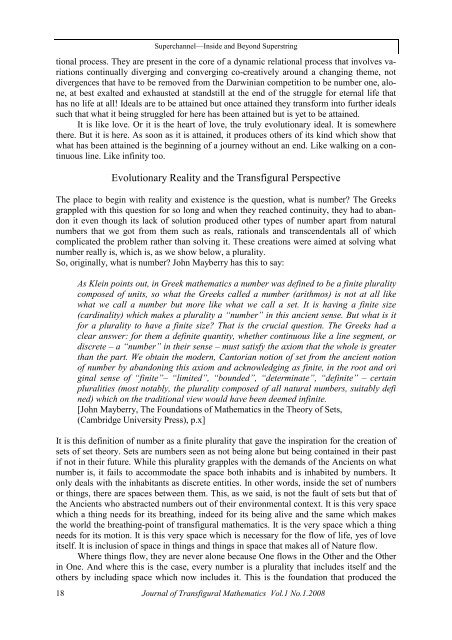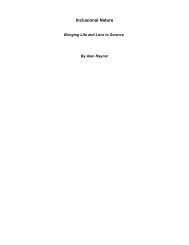JTfM Vol 1 No 1 2008 - ONLINE EDITION - Inclusionality Research
JTfM Vol 1 No 1 2008 - ONLINE EDITION - Inclusionality Research
JTfM Vol 1 No 1 2008 - ONLINE EDITION - Inclusionality Research
Create successful ePaper yourself
Turn your PDF publications into a flip-book with our unique Google optimized e-Paper software.
Superchannel—Inside and Beyond Superstring<br />
tional process. They are present in the core of a dynamic relational process that involves variations<br />
continually diverging and converging co-creatively around a changing theme, not<br />
divergences that have to be removed from the Darwinian competition to be number one, alone,<br />
at best exalted and exhausted at standstill at the end of the struggle for eternal life that<br />
has no life at all! Ideals are to be attained but once attained they transform into further ideals<br />
such that what it being struggled for here has been attained but is yet to be attained.<br />
It is like love. Or it is the heart of love, the truly evolutionary ideal. It is somewhere<br />
there. But it is here. As soon as it is attained, it produces others of its kind which show that<br />
what has been attained is the beginning of a journey without an end. Like walking on a continuous<br />
line. Like infinity too.<br />
Evolutionary Reality and the Transfigural Perspective<br />
The place to begin with reality and existence is the question, what is number? The Greeks<br />
grappled with this question for so long and when they reached continuity, they had to abandon<br />
it even though its lack of solution produced other types of number apart from natural<br />
numbers that we got from them such as reals, rationals and transcendentals all of which<br />
complicated the problem rather than solving it. These creations were aimed at solving what<br />
number really is, which is, as we show below, a plurality.<br />
So, originally, what is number? John Mayberry has this to say:<br />
As Klein points out, in Greek mathematics a number was defined to be a finite plurality<br />
composed of units, so what the Greeks called a number (arithmos) is not at all like<br />
what we call a number but more like what we call a set. It is having a finite size<br />
(cardinality) which makes a plurality a “number” in this ancient sense. But what is it<br />
for a plurality to have a finite size? That is the crucial question. The Greeks had a<br />
clear answer: for them a definite quantity, whether continuous like a line segment, or<br />
discrete – a “number” in their sense – must satisfy the axiom that the whole is greater<br />
than the part. We obtain the modern, Cantorian notion of set from the ancient notion<br />
of number by abandoning this axiom and acknowledging as finite, in the root and ori<br />
ginal sense of “finite”– “limited”, “bounded”, “determinate”, “definite” – certain<br />
pluralities (most notably, the plurality composed of all natural numbers, suitably defi<br />
ned) which on the traditional view would have been deemed infinite.<br />
[John Mayberry, The Foundations of Mathematics in the Theory of Sets,<br />
(Cambridge University Press), p.x]<br />
It is this definition of number as a finite plurality that gave the inspiration for the creation of<br />
sets of set theory. Sets are numbers seen as not being alone but being contained in their past<br />
if not in their future. While this plurality grapples with the demands of the Ancients on what<br />
number is, it fails to accommodate the space both inhabits and is inhabited by numbers. It<br />
only deals with the inhabitants as discrete entities. In other words, inside the set of numbers<br />
or things, there are spaces between them. This, as we said, is not the fault of sets but that of<br />
the Ancients who abstracted numbers out of their environmental context. It is this very space<br />
which a thing needs for its breathing, indeed for its being alive and the same which makes<br />
the world the breathing-point of transfigural mathematics. It is the very space which a thing<br />
needs for its motion. It is this very space which is necessary for the flow of life, yes of love<br />
itself. It is inclusion of space in things and things in space that makes all of Nature flow.<br />
Where things flow, they are never alone because One flows in the Other and the Other<br />
in One. And where this is the case, every number is a plurality that includes itself and the<br />
others by including space which now includes it. This is the foundation that produced the<br />
18<br />
Journal of Transfigural Mathematics <strong>Vol</strong>.1 <strong>No</strong>.1.<strong>2008</strong>




